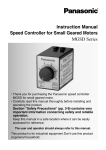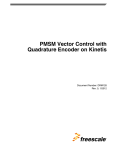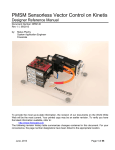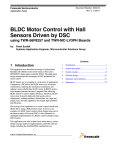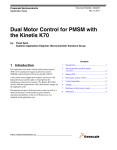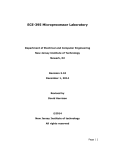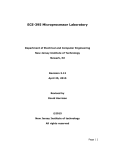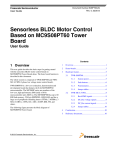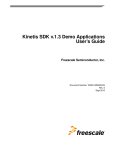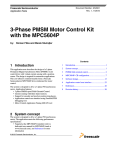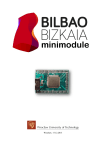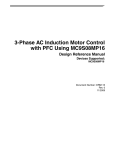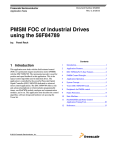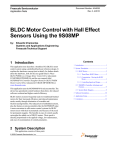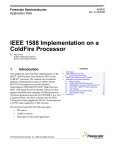Download AN5049 - Freescale Semiconductor
Transcript
Freescale Semiconductor Application Note Document Number: AN5049 Rev. 0, 12/2014 Three-Phase PMSM Sensorless FOC Using the MKV10Z32 with Automated Motor Parameters Identification by: Josef Tkadlec Contents 1 Introduction This application note accompanies the Sensorless PMSM Field-Oriented Control Design Reference Manual (DRM148) [1]. This application note describes the MCU peripherals used in the PMSM sensorless vector control application, the hardware set-up, and results of the measurement. In addition, the attached application code contains routines for Automated PMSM parameters identification. 2 MCU Peripherals Table 1 summarizes the peripherals on the Kinetis MKV10Z32 MCU [4] and their usage by the PMSM sensorless vector control application. © 2014 Freescale Semiconductor, Inc. 1 Introduction.............................. .............................. 1 2 MCU Peripherals..................................................... 1 3 Interrupts.............................. ................................... 8 4 Application Operation................. ..........................10 5 Project File Structure..................... ....................... 14 6 Memory Usage.......................... ............................16 7 Hardware Setup.....................................................16 8 Measurement Results............................................ 18 9 Conclusion.............................................................19 10 References............................. ................................19 11 Acronyms and Abbreviated Terms.... ...................19 MCU Peripherals Table 1. Kinetis KV10Z32 Peripherals Overview Kinetis KV10 peripherals Group Analog Communications Timers Other Module Used in the application Number of modules or channels Purpose ADC0 11 channels single ended, 2 of them differential pairs 2 channels DC-bus voltage and motor phase currents sensing ADC1 11 channels single ended, 2 of them differential pairs 3 channels Comparators 2 modules, each 7 channels — — DAC 1 module — — SPI 1 module, 4 chip select 1 module signals MOSFET driver configuration UART 2 modules 1 module FreeMASTER communication I2C 1 — — FlexTimer 6 channels 6 channels Generation 6-channels PWM for motor control 2 channels 1 channel Generation of slow loop interrupt 2 channels — — PDB 8 channels for ADC triggering 2 channels DC-bus voltage and phase current sampling initiation LPT 1 module — — eDMA 4 channels — — 2.1 FlexTimer0 configuration to generate a 6-channel PWM The FlexTimer Module (FTM) is a two to eight channel timer which supports input capture, output compare, and the generation of PWM signals to control an electric motor and power management applications. The FTM time reference is a 16-bit counter that can be used as an unsigned or signed counter. On the Kinetis KV10 MCUs there are three instances of FTM. One FTM has 6 channels, the other two FTMs have 2 channels. The FTM0 is clocked from the system clock (75 MHz), and the generated PWM has a frequency of 20 kHz (period 50 us), therefore MODULO must be 3750 (CNTIN register –1875, MOD1 1874). There is an interrupt generated every second PWM reload by FTM0 (period 100 us = 10 kHz). This interrupt serves to calculate fast loop (Current FOC) algorithms. The procedure of the FlexTimer configuration for generating a center-aligned PWM with dead time insertion is described in [2]. Because [2] supports an earlier version (1.0) of the FlexTimer, and with regards to the hardware used (TWR-MC-LV3PH), there are a few differences in the configuration, as follows: • It is necessary to enable the system clock for the FlexTimer module in the Clock Gating Control register: SIM→SCGC6 |= SIM_SCGC6_FTM0_MASK; • It is necessary to disable the write protection of some registers before they can be updated: Three-Phase PMSM Sensorless FOC Using the MKV10Z32 with Automated Motor Parameters Identification, Rev. 0, 12/2014 2 Freescale Semiconductor, Inc. MCU Peripherals FTM0→MODE |= FTM_MODE_WPDIS_MASK; • It is recommended to enable the internal FlexTimer counter to run in the debug mode: FTM0→CONF |= FTM_CONF_BDMMODE(3); • When the HW debugging interface (jLink, Multilink,…) is connected to the microcontroller, the MCU is in debug mode. This is not dependent on running code containing breakpoints. • The PWM signals generated by the FlexTimer0 are directly connected to the MOSFET driver. Because of safety reasons, the input signals for the top transistors on the MOSFET driver used on the Freescale Tower System development board low-voltage power stage have inverse polarity. Therefore, it is also necessary to set the right polarity of the PWM signals: FTM0→POL = FTM_POL_POL0_MASK | FTM_POL_POL2_MASK | FTM_POL_POL4_MASK; • The duty cycle is changed by changing the value of the FlexTimer Value registers. These registers are double-buffered, meaning that their values are updated not only by writing the number, but also by confirming the change by setting the Load Enable (LDOK) bit. This ensures that all values are updated at the same instance: FTM0→PWMLOAD = FTM_PWMLOAD_LDOK_MASK; It is necessary to write the LDOK bit every time the value registers are changed, so not only at the stage of loading them with initial values, but with every update after the duty cycle value is computed in the vector control algorithm. • Within the application, hardware triggering of the AD converter is employed. The Initialization Trigger signal from the FlexTimer is used as the primary triggering signal which is fed into the Programmable Delay Block that services the timing of the AD conversion initiation. FTM0→EXTTRIG |= FTM_EXTTRIG_INITTRIGEN_MASK; • FTM0 interrupt is generated on every second PWM reload: FTM0->SC |= FTM_SC_TOIE_MASK; FTM0->CONF |= FTM_CONF_NUMTOF(1); • Finally, the output pins of the MCU must be configured, to bring out the signals from the chip. The assignment of signals to output pins is set in the Pin Control Register. The available signals are listed in the Signal Multiplexing chapter of [3] and are package dependent. PORTC->PCR[1] = PORT_PCR_MUX(4); // FTM0 CH0 PORTE->PCR[25] = PORT_PCR_MUX(3); // FTM0 CH1 PORTC->PCR[3] = PORT_PCR_MUX(4); // FTM0 CH2 PORTC->PCR[4] = PORT_PCR_MUX(4); // FTM0 CH3 PORTD->PCR[4] = PORT_PCR_MUX(4); // FTM0 CH4 PORTD->PCR[5] = PORT_PCR_MUX(4); // FTM0 CH5 The port settings implemented in the application code reflect the hardware solution built on the Tower System development modules. 2.2 FlexTimer2 configuration to generate a slow loop interrupt Three-Phase PMSM Sensorless FOC Using the MKV10Z32 with Automated Motor Parameters Identification, Rev. 0, 12/2014 Freescale Semiconductor, Inc. 3 MCU Peripherals The Flex Timer Module 2 (FTM2) is configured to generate an independent interrupt that serves to calculate slow loop (Speed FOC) algorithms. The slow loop interrupt is processed with lower priority than the fast loop interrupt. Separation of the slow and fast state machine shortens the necessary length of the fast loop interrupt. Prescale factor (FTM2_SC -> PS) is 16 and modulo register (FTM2_MOD) is set to 75000/16 therefore FTM2 counter overflows and generates the slow loop interrupt with frequency 1kHz. 2.3 ADC and PDB modules configuration The on-chip ADC module is used to sample feedback signals (motor phase currents and DC-bus voltage) that are necessary to successfully perform the vector control algorithm. The Programmable Delay Block closely cooperates with the ADC and triggers the hardware for sampling. It is required to perform a self-calibrating procedure of the ADC module before it is used in the application to obtain the specified accuracy. The calibration process also requires a programmer’s intervention—that is, to generate the plus-side and minus-side gain calibration results and store them in the ADC plus-side and minus-side gain registers after the calibration function completes. The calibration must be performed for both ADC modules. After calibration, the ADC modules are configured to a 12-bit accuracy. The CPU frequency is set to 75 MHz, so by using available prescaler values the input clock to the ADC module is set to 12.5 MHz. That setting yields a conversion time of 2.64 μs (33 ADC clock cycles). Finally, the hardware trigger must be enabled in the Status and Control Register 2. The Programmable Delay Block (PDB) provides controllable delays from either an internal or an external trigger, or a programmable interval tick, to the hardware trigger inputs of the ADCs, so that a precise timing between ADC conversions is achieved. The PDB module has an internal counter that overflows on a modulo value. Because the input trigger periodically comes from FTM0, the value of the modulo register can be set to its reset value. The values in the channel delay registers are set to generate triggers to start sampling the DC-bus voltage and the motor phase AD conversions. The PDB module on the KV10 MCU allows 15 different input trigger sources. They are listed in the Chip configuration chapter, in section PDB Configuration in [4]. Similarly, as for FTM0, the LDOK bit must be set to acknowledge the changes in the delay registers. On the KV10 MCU the clock source for the PDB is different than the FTM—that is, the PDB and the ADC use the Bus Clock and the FTM uses the System Clock. 2.4 ADC conversion timing, currents and voltage sampling FlexTimer0 is configured to trigger an internal hardware signal when its counter is reset after overflow to the initialization value. This signal is fed into the Programmable Delay Block (PDB) that consequently triggers the AD conversion of the voltage and currents with a predefined delay. On the Kinetis KV10 75 MHz MCU, two ADC modules are implemented. Each ADC module associates to one channel of the PDB module. Each ADC module has two result registers (two channels), and they correspond to two programmable pre-trigger delays of the PDB channels. So it is possible to perform four AD conversions without requesting an interrupt (with respect that the DMA is not used for data transfer). In this application, only three conversions need to be triggered without CPU intervention (two motor phase currents and the DC-Bus voltage). Figure 1 shows the module interconnections and the ADC interrupt generation. Three-Phase PMSM Sensorless FOC Using the MKV10Z32 with Automated Motor Parameters Identification, Rev. 0, 12/2014 4 Freescale Semiconductor, Inc. MCU Peripherals Figure 1. ADC conversion timing diagram 2.5 Current measurement Closely related to the ADC conversion trigger timing is the assignment of the ADC channels to the measured analog signals. For computation of the fast (current) control loop of the FOC, it is necessary to know the values of all three motor phase currents. Because there are only two ADC modules, it is possible to sample only two analog quantities in one instance. Assuming the motor represents a symmetrical three-phase system, the sum of all three instantaneous phase currents is zero. Equation 1 Because the phase currents are measured the instance when the bottom transistors are conducting, in the case of high duty cycle ratios (current value is in the area of the maximum of the sine curve), the time when the current can be measured is too short. The bottom transistor must be switched on at least for a critical pulse width to get a stabilized current shunt resistor voltage drop. The selection of the channels is determined based on the section when the space vector of the stator current is generated. This assignment is performed at the end of the ADC1 interrupt service routine. Therefore, it is enough to sample only two phase currents while the third is easily calculated according to Equation 2 on page 6. Three-Phase PMSM Sensorless FOC Using the MKV10Z32 with Automated Motor Parameters Identification, Rev. 0, 12/2014 Freescale Semiconductor, Inc. 5 MCU Peripherals Equation 2 Figure 2 illustrates two cases (case I at 30°, case II at 60°) which explain why calculating the third current is necessary. Figure 2. Current sensing Three-Phase PMSM Sensorless FOC Using the MKV10Z32 with Automated Motor Parameters Identification, Rev. 0, 12/2014 6 Freescale Semiconductor, Inc. MCU Peripherals 2.6 Overcurrent level The overcurrent signal is connected via the TWR-Elevator IRQ_A (B62) pin to the GPIO_B2 pin of the MKV10Z32 device. This pin is internally connected to the FTM0_FLT1 signal that handles the fault by PWM hardware. See Figure 3. The overcurrent level can be set in the range of 0~8 A by the trimmer R37 on the TWR-MC-LV3PH board. The maximum current level can be set by turning the trimmer counterclockwise. The user can find the level by turning the trimmer counterclockwise while the motor is running until the red LED is lit. It is recommended to set the trimmer to a somewhat higher level, so that the motor can operate at maximum speed. Figure 3. Overcurrent level 2.7 SPI configuration The SPI interface is used in the application for communication between the intelligent MOSFET gate driver MC33937 and the KV10 MCU. The MC33937 gate driver is placed on the Tower System low-voltage power module and serves for driving the high-side and low-side MOSFET transistors of the three-phase inverter. In the application, the initialization of the MC33937 must be performed, primarily to set dead time. During the motor operation there is also periodic checking of the status register of the driver, to provide information on the latched faults. The MC33937 driver requires precise timing of the SPI signals. The default setting of the SPI module on the MCU is not possible to use. The exact timing of the SPI signals is listed in [5]. 2.8 SCI (UART) configuration The SCI is used in the application for the communication between the master system and the embedded application. A master system is the notebook or the PC where the FreeMASTER software is installed to control the application and visualization of its state. On the Kinetis KV10, there are two UART modules implemented. Because the hardware solution is based on the Tower System development boards, the UART1 is used. The communication speed is set to 19200 Bd and is limited by use of the OpenSDA - CDC serial communication driver. The use of direct RS232 connection between the PC and the embedded side enables an increase of the communication speed to 115200 Bd. Three-Phase PMSM Sensorless FOC Using the MKV10Z32 with Automated Motor Parameters Identification, Rev. 0, 12/2014 Freescale Semiconductor, Inc. 7 Interrupts 3 Interrupts In the application there are 4 interrupts in total. FTM0 interrupt serves to execute fast loop (Current FOC) algorithms, FTM2 serves to execute slow loop (Speed FOC) algorithms, ports interrupt handles user buttons and PDB error interrupt clears the sequence error fault. 3.1 FTM0 interrupt This interrupt request executes fast loop state machine and is triggered every second PWM reload. In the beginning of the FTM0 ISR execution an application state machine function is called. If the application is in the Run state, then it is followed by the execution of the fast (current) control loop of the PMSM vector control algorithm, including the position and speed estimation. The interrupt flag is cleared by writing 0 to TOF bit in FTM0->SC register. The flow chart depicted on the Figure 4 provides an overview of the program flow during execution of the FTM0 interrupt service routine when the application is in Run state and Spin sub-state. Figure 4. FTM0 ISR flow chart Three-Phase PMSM Sensorless FOC Using the MKV10Z32 with Automated Motor Parameters Identification, Rev. 0, 12/2014 8 Freescale Semiconductor, Inc. Interrupts 3.2 FTM2 interrupt This interrupt request executes slow loop state machine and is triggered when FTM2 overflows therefore it is independent on FTM0 interrupt. Speed control functions are called in this interrupt. The interrupt flag is cleared by writing 0 to TOF bit in FTM2->SC register. The flow chart depicted in Figure 5 provides an overview of the program flow during execution of the FTM2 interrupt service routine when the application is in the Run state and the Spin sub-state. Figure 5. FTM2 ISR flow chart 3.3 Ports interrupt Handling of the user’s button on the Kinetis KV10 MCU Tower System controller board is performed in the ISR associated with the Ports interrupt, generated whenever the SW2 button is pressed. At the beginning, the interrupt flag is cleared. Pressing the SW2 button enables/disables the Demo mode. The first pressing of the SW2 button puts the application state into RUN mode and the required speed is changed in several steps according to a predefined profile. The subsequent press of the SW2 button returns the application to STOP mode. More about the application control is available in Application Operation. Using the FreeMASTER control interface enables enhanced control and diagnostic. 3.4 PDB error interrupt The PDB error ISR serves to clear the sequence error fault that is generated in situations when PDB initiates the sampling of the AD converter even though the COCO flag in the specific ADCx_SC1n register of the ADC module was not cleared. The values from the result registers are not read, due to the reasons described as follows. Three-Phase PMSM Sensorless FOC Using the MKV10Z32 with Automated Motor Parameters Identification, Rev. 0, 12/2014 Freescale Semiconductor, Inc. 9 Application Operation • One scenario is when the PDB counter stops working and an interrupt is asserted. The ISR in the PDB module is then re-initiated. The PDB generates a trigger signal with the same period as the ADC conversion complete interrupt which is also the same as the PWM period. If the user places an interrupt in the code, this stops execution. However, the PDB generates a trigger for the next conversion, even when the program execution stops. The COCO flags are not cleared and the PDB generates a sequence error. • Another scenario is when the execution of the ADC conversion complete interrupt (when the fast control loop is calculated) extends over one period of the PWM. This occurs if the user enters additional tasks into the ADC conversion complete interrupt. In addition to the generation of PDB sequence error, the more serious impact is on the quality of the control process, as one of the key assumptions is not met—the execution of control algorithms to extend the sampling period. The real-time control application must be designed in such a way that this situation never occurs. 4 Application Operation The application can be operated either with the user button on the TWR-KV10Z32 MCU board (as mentioned in Ports interrupt) or by using the FreeMASTER software, which enables visualizing the application variables. The FreeMASTER application consists of two parts, the PC application used for variables visualization, and the set of software drivers running in the embedded application. The data between the PC and the embedded application is passed via the RS232 interface. 4.1 FreeMASTER installation on the PC or notebook The FreeMASTER PC application can be downloaded from the Freescale webpage: http://www.freescale.com/freemaster; from the “Download” tab, select “FreeMASTER 1.4 Application Installation”. Because downloading the FreeMASTER application requires registration, it is necessary to create an account before you can log-in. After you log into the system, the license agreement appears. You should read the license agreement and then you have to accept the agreement by clicking the “I Accept” button. If you are using Internet Explorer, then at the top of the web page you will see a bar asking to authorize the file download. Click on the bar and select "Download File". A dialog box appears where you can choose to either Run or Save. In both cases, the installation archive will be stored on your machine. By selecting the “Save”, you have the option to select your preferred location for saving the installation archive, otherwise it will be saved to a Temporary folder created by your system. The library installation archive will be now downloaded to your computer. To run the installation, click the “Run” button. Follow the instructions on the screen to complete the installation process. 4.2 Establishing the connection between the PC and the embedded application The FreeMASTER allows using multiple communication interfaces between the embedded application and the PC or notebook (UART (RS232), CAN, Ethernet, USB, BDM, etc). For this application, the RS232 was used because the software overhead for the data transfer represents the lowest additional load on the CPU. Nowadays, notebooks are not equipped with the COM port, so for this purpose the TWR-KV10Z32 module has in place a USB-to-RS232 interface (CDC Serial Port). By connecting the TWR-KV10Z32 module with a notebook via the USB cable, a virtual serial port will be established in the Windows system. 4.3 Application operation using FreeMASTER Three-Phase PMSM Sensorless FOC Using the MKV10Z32 with Automated Motor Parameters Identification, Rev. 0, 12/2014 10 Freescale Semiconductor, Inc. Application Operation To run the FreeMASTER application, double click on the PMSM_FOC_KV1x.pmp file located in the \freemaster \PMSM_Sensorless_FOC_MID folder. The FreeMASTER application starts and the environment will be automatically created, as it is defined in the *.pmp file. 4.3.1 Setting up the communication When the notebook is connected via USB cable with the TWR-KV10Z32 board, the operating system assigns the number of the COM port to the OpenSDA CDC Serial Port. This number is assigned randomly, therefore it is necessary to set the right communication port each time the connection is established (re-plugging the USB cable might cause a different port number assignment). To set the port number, click the menu item Project \ Options … Then assign the port number in the “Comm” tab of the opened window.The correct port number selection is confirmed by the text “OpenSDA – CDC Serial Port” next to the list box with the available serial port numbers. Figure 6. FreeMASTER communication settings 4.3.2 Application operation 4.3.2.1 Start/Stop the communication When the communication settings are performed, the communication between the PC and the embedded application can be initiated. Click the STOP button in the FreeMASTER toolbar as shown in following picture: Three-Phase PMSM Sensorless FOC Using the MKV10Z32 with Automated Motor Parameters Identification, Rev. 0, 12/2014 Freescale Semiconductor, Inc. 11 Application Operation Figure 7. Initiating the communication with the embedded side 4.3.2.2 Start/Stop the application, required speed setting The next step is to switch the application to the RUN state. In the FreeMASTER window in the Variable Watch grid, click on the drop-down list next to the “Application Switch” variable name, and select “ON” as the following picture illustrates: Figure 8. Start the application Once the application is set to the RUN state, the required speed can be changed to some non-zero value. The procedure is similar as in the previous step; in the Variable Watch grid, enter a positive or negative value next to the “Speed Required” variable name. 4.3.2.3 Operation of the application from the control page The application can also be operated from the control page, see the description in Figure 9. Three-Phase PMSM Sensorless FOC Using the MKV10Z32 with Automated Motor Parameters Identification, Rev. 0, 12/2014 12 Freescale Semiconductor, Inc. Application Operation Figure 9. FreeMASTER control page 4.3.2.4 Scopes and Recorders One of the main benefits of the FreeMASTER application is to visualize the values of the variables in real time. For this purpose, there are two possibilities. The user can select between the Scope and the Recorder. While the Scope feature downloads a stream of the data continuously in real time, the Recorder stores the data in a buffer located in the RAM of the embedded MCU and, after a trigger condition is met, the data is transferred in blocks via the communication interface and visualized in the FreeMASTER window. The sampling period of the Scope is limited by the speed of the communication interface, and therefore is used for slowly changing quantities such as the speed. The sampling period of the oscilloscope-like Recorder is in the microseconds range, enabling visualization of quickly changing quantities, such as the phase currents or the duty cycles. In this application, the recorder buffer is updated each time the fast control loop is executed, that is, every 100 us. The following picture shows the Recorders and Scopes that can be used when the application is running in the “Speed FOC” control mode. Three-Phase PMSM Sensorless FOC Using the MKV10Z32 with Automated Motor Parameters Identification, Rev. 0, 12/2014 Freescale Semiconductor, Inc. 13 Project File Structure Figure 10. Scopes and recorders used in Speed FOC control mode 4.4 MCAT tool control To run the FreeMASTER application including MCAT tool, double click on the MCAT_PMSM_FOC_KV1x.pmp file located in the \freemaster\PMSM_Sensorless_FOC_MID folder. The FreeMASTER application starts and the environment will be automatically created, as it is defined in the *.pmp file. The application enables tuning of the PMSM sensorless application to any motor. For this purpose, the field oriented control can be divided into four modes as follows: • • • • Scalar Voltage FOC Current FOC Speed FOC This enables tuning of the application during several steps, with each step containing a limited number of unknown parameters that can be adjusted. To switch between these modes, an MCAT tab “Control Struc” is used. For more information on tuning the application to any motor, see [6]. 4.4.1 Automated PMSM parameters identification The application code contains routines for a PM synchronous motor parameters identification. The algorithm simplifies and speeds up controller constant calculations and settings. The identification process is disabled by default in the application and can be enabled from the MCAT control tab “Motor Identif”. For more information on user motor identification, see Freescale document AN4986, “Automated PMSM Parameter Identification” [7]. 5 Project File Structure The total number of source (*.c) and header files (*.h) in this project exceeds one hundred. Therefore, only the key project files will be described in detail, and the remainder will be summarized in groups. Three-Phase PMSM Sensorless FOC Using the MKV10Z32 with Automated Motor Parameters Identification, Rev. 0, 12/2014 14 Freescale Semiconductor, Inc. Project File Structure The main project folder is divided into three directories: • build\iar\kv10\PMSM_Sensorless—contains the configuration files for the IAR compiler as well as the compiler’s output executable and object files. If the IAR Embedded Workbench for ARM is installed on your computer, double clicking the workspace file PMSM_SAC_SENSORLESS.eww located in the directory \build\iar\ launches the IAR IDE. • freemaster\PMSM_Sensorless—contains the FreeMASTER configuration file PMSM_FOC_KV1x.pmp and supporting files (control page in HTML format and the binary file with addresses of the variables). It also contains the FreeMASTER project for the Motor Control Application Tuning Tool PMSM_FOC_KV1x_MCAT.pmp. • src—contains the project source and header files, and its contents will be described in the following text: Files in the src\projects\kv10\PMSM_Sensorless_FOC folder: • main.c and main.h contain the basic application initialization (enabling interrupts), subroutines to access the MCU peripherals, and interrupt service routines. In the background infinite loop the FreeMASTER communication is performed. • state_machine.c and state_machine.h contain the application state machine structure definition and handles the switching between the application states and application states’ transitions. • motor_structure.c and motor_structure.h contain the structure definitions and subroutines dedicated to perform the motor control algorithm (vector control algorithm, position and speed estimation algorithm, speed control loop). • M1_statemachine.c and M1_statemachine.h contain the software routines that are executed when the application is in the particular state or state transition. • freemaster_cfg.h configuration file for the FreeMASTER interface. • PMSM_appconfig.h contains the constant definitions of the application control processes (parameters of the motor and controllers and the constants for other vector control related algorithms). When the application is tailored for another motor using the Motor Control Application Tuning Tool, this file is generated by the tool at the end of the tuning process. • \peripherals\ folder contains the important files for static configuration of the peripherals used in the application (FlexTimers, ADC, PDB, SPI). Subdirectories in the src\ folder: • \common\ and \cpu\ folders containing CPU initialization routines. • \cpu\isr.h an important file with definitions of the peripherals interrupt service routines assigned to the interrupt vectors. In this file, the user can add the definition of an ISR for an additional peripheral interrupt. • \drivers\ files in the subdirectories contain generic source and header files for UART and watchdog configuration, as well as the CPU clock settings routines. • \platforms\tower.h contains the Tower System development board definitions for Kinetis (CPU speed and UART parameters). • \platforms\MKV10Z7.h is the header file containing macro definitions of all the MCU registers and register bits. Files in the src\MMCLIB\ folder: • CM0+_MMCLIB_IAR.a software library containing motor control, general math and filter algorithms. Additional files in the folder and subfolders are associated header files, each one for a particular function of the library. • ACLIB\CM0+_ACLIB_IAR_r0.2.a contains the advanced control algorithms for rotor position and speed estimation (Back-EMF observer and Tracking observer). Other subdirectories in the src\ folders: Three-Phase PMSM Sensorless FOC Using the MKV10Z32 with Automated Motor Parameters Identification, Rev. 0, 12/2014 Freescale Semiconductor, Inc. 15 Memory Usage • \FreeMASTER contains all source files of the FreeMASTER application, it is not necessary to access it or change anything inside. The interface to the programmer is only via freemaster_cfg.h file located in src\projects \kv10\PMSM_Sensorless folder. • \SAC\ folder (Sensor and Actuator Components) contains routines to access peripherals used by the motor control algorithm to sense input feedback physical quantities (currents, voltage, speed, position) and to set the actuators based on calculated output variables (FlexTimer, MOSFET pre-driver). 6 Memory Usage Table 2 summarizes the chip memories usage: Table 2. Total Memory Usage Memory Type Total Memory Available on the Kinetis MKV10Z32 Used by the Application [ Bytes ] 32KB 22,970 Program Flash (application code) Data Flash (application constants) 1,650 Data RAM (application variables) 8KB 6,6141 1. Including 4096 bytes of FreeMASTER recorder buffer. Table 3 summarizes the chip memories usage for selected algorithm blocks: Table 3. Algorithm Blocks Memory Usage Algorithm Block Program Memory (Code + Constants) Data Memory [ Bytes ] [ Bytes ] FOC (fast + slow loops) 5,114 0 FreeMASTER 2,572 4,305 SAC (Sensor and Actuator Components) 2,974 3 MID (Motor Identification) 4,252 590 Application State Machine 4,764 676 7 Hardware Setup The Tower System development board platform is used as the hardware platform for the PMSM sensorless on Kinetis MKV10Z32. It consists of the following modules: • Tower System elevator modules (TWR-ELEV) • Kinetis MKV10Z32 Tower System module (TWR-KV10Z32) • Three-phase low-voltage power module (TWR-MC-LV3PH) with included motor All modules of the Tower System development platform are available for order via the Freescale web page or from distributors, so the user can easily build the hardware platform for which the application is targeted. Three-Phase PMSM Sensorless FOC Using the MKV10Z32 with Automated Motor Parameters Identification, Rev. 0, 12/2014 16 Freescale Semiconductor, Inc. Hardware Setup 7.1 Hardware set-up and jumpers configuration Building the system using the modules of the Tower System is not difficult. The peripheral modules and the MCU module are plugged into the elevator connectors, while the white stripe on the side of the module boards determines the orientation to the Functional elevator (the elevator with the mini USB connector, power supplies and the switch). It is necessary to configure jumpers on both the TWR-KV10Z32 module and the TWR-MC-LV3PH module. The jumper settings for TWR-KV10Z32 board are listed and highlighted in the following table. Table 4. Jumper Settings of TWR-KV10Z32 Board Jumper # Setting Jumper # Setting J1 2-3 J14 open J2 1-2 J18 2-3 J3 2-3 J19 2-3 J4 1-2 J20 2-3 J5 1-2 J21 3-4 J7 1-2 J22 3-4 J8 2-3 J25 open J9 1-2 J26 1-2 J10 2-3 J27 1-2 J11 open J28 1-2 J12 open J29 1-2 J13 open Three-Phase PMSM Sensorless FOC Using the MKV10Z32 with Automated Motor Parameters Identification, Rev. 0, 12/2014 Freescale Semiconductor, Inc. 17 Measurement Results The jumper settings for TWR-MC-LV3PH board are listed and highlighted in the following table. See also the user’s manual [7] for more details (for example the hardware overcurrent threshold setting) of the TWR-MC-LV3PH stage. Table 5. Jumper Settings of TWR-MC-LV3PH Board Jumper # Setting J2 1-2 J3 1-2 J10 1-2 J11 1-2 J12 1-2 J13 1-2 J14 1-2 8 Measurement Results 8.1 CPU load and the execution time The CPU load is influenced mainly by the execution of the FTM0 ISR, in which the execution of the application state machine and calculation of the fast (current) control loop of the PMSM vector control is performed. Table 6 shows machine cycle number measured from FTM0 ISR routine excluding FreeMASTER recorder function in RUN state for the worst case of RUN STATE—that is, a transition from open loop startup to close loop speed control. The FTM0 interrupt is generated periodically with a half frequency as the PWM reload event, when the values of the duty cycles are updated. In this application, the FTM0 ISR is generated once per 100μs, which corresponds to 10 kHz (20 kHz PWM frequency). At 75MHz on the Kinetis MKV10Z32 device, it consumes up to 72% of CPU performance. Table 6. CPU Load (CPU Clock 75 MHz) Algorithm Block FOC + open loop start-up CPU Cycles Execution Time [usec] Note 5,418 72.2 RUN state worst case Three-Phase PMSM Sensorless FOC Using the MKV10Z32 with Automated Motor Parameters Identification, Rev. 0, 12/2014 18 Freescale Semiconductor, Inc. Conclusion 9 Conclusion The results of the execution time measurement show that the Kinetis MKV10Z32 microcontroller can be used to drive the PMSM sensorless vector control algorithm for high dynamic applications. The CPU load at 10 kHz FOC calculation frequency is about 72 %, so there is much room to either to increase the frequency of the fast control loop or to perform additional user’s tasks. 10 References The following references are available on http://www.freescale.com with the exception of [3]: [1] Sensorless PMSM Field-Oriented Control (Document number DRM148) [2] Using FlexTimer in ACIM/PMSM Motor Control Applications (Document number AN3729) [3] A New Starting Method of BLDC Motors Without Position Sensor, Wook-Jin Lee, Seung-Ki Sul, 2006 [4] KV10 Sub-Family Reference Manual (Document number KV10P48M75RM) [5] Three Phase Field Effect Transistor Pre-driver Data Sheet (Document number MC33937) [6] Tuning 3- Phase PMSM Sensorless Control Application Using MCAT Tool (Document number AN4912) [7] Automated PMSM Parameters Identification (Document number AN4986) [8] TWR-MC-LV3PH User’s Manual (Document number TWRMCLV3PHUG) 11 Acronyms and Abbreviated Terms Table 7 contains abbreviated terms used in this document. Table 7. Acronyms and Abbreviated Terms Term Meaning ADC Analog to Digital Converter Back-EMF Back electromotive force – a voltage generated by rotating motor PMSM Permanent Magnet Synchronous Motor PWM Pulse-Width Modulation Three-Phase PMSM Sensorless FOC Using the MKV10Z32 with Automated Motor Parameters Identification, Rev. 0, 12/2014 Freescale Semiconductor, Inc. 19 How to Reach Us: Home Page: freescale.com Web Support: freescale.com/support Information in this document is provided solely to enable system and software implementers to use Freescale products. There are no express or implied copyright licenses granted hereunder to design or fabricate any integrated circuits based on the information in this document. Freescale reserves the right to make changes without further notice to any products herein. Freescale makes no warranty, representation, or guarantee regarding the suitability of its products for any particular purpose, nor does Freescale assume any liability arising out of the application or use of any product or circuit, and specifically disclaims any and all liability, including without limitation consequential or incidental damages. “Typical” parameters that may be provided in Freescale data sheets and/or specifications can and do vary in different applications, and actual performance may vary over time. All operating parameters, including “typicals,” must be validated for each customer application by customer's technical experts. Freescale does not convey any license under its patent rights nor the rights of others. Freescale sells products pursuant to standard terms and conditions of sale, which can be found at the following address: freescale.com/SalesTermsandConditions. Freescale, the Freescale logo, and Kinetis are trademarks of Freescale Semiconductor, Inc., Reg. U.S. Pat. & Tm. Off. Tower is a trademark of Freescale Semiconductor, Inc. All other product or service names are the property of their respective owners. ARM and the ARM Powered logo are registered trademarks of ARM Limited (or its subsidiaries) in the EU and/or elsewhere. © 2014 Freescale Semiconductor, Inc. Document Number AN5049 Revision 0, 12/2014




















